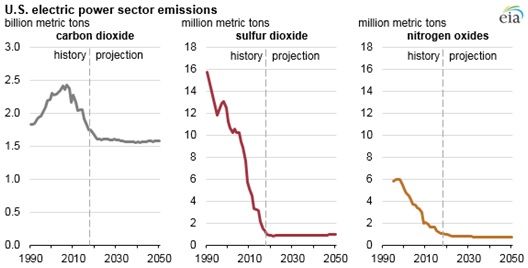US carbon emissions likely to remain flat through 2050
“EIA’s recently released Annual Energy Outlook 2019 projects that the U.S. electric power sector emissions of sulfur dioxide (SO2), nitrogen oxides (NOx), and carbon dioxide (CO2) will remain mostly flat through 2050, assuming no changes to current laws and regulations.

…..CO2 emissions in the U.S. electric power sector have been generally declining since their 2007 peak of 2.4 billion metric tons (mt).”
The Outlook itself offers a few numbers to support its case. I have extracted the specific numbers for CO2 Emissions as I did in November 2018 in a piece entitled “We’re wasting time”
(http://www.base-e.net/blog-24-quot;were-wasting-timequot).

We’re still wasting time, and the “mostly flat” term seems to be an attempt to put a positive “spin” on the fact that CO2 emissions are flat.
And, the starting point for the commentary remains the 2007 peak period and generates a “feel good” reduction. But, this is not a “feel good” outcome.
I don’t want to overcomplicate things. Flat is bad….down is good!
We need absolute reductions.
The Reference Case numbers are virtually the same as they were in November. Some of the side cases have been moderated, but the reference cases, normally representing the best of the estimates, are virtually unchanged.
And, the impact of the much less talked about Clean Power Plan remains minimal at 259 million metric tonnes (0.259Gt). This projected reduction is only 5% of the Reference Case.
CO2 emissions need to drop to ¼ of where they are currently projected to be on the 2°C trajectory, not flat. (http://www.base-e.net/blog-24-quot;were-wasting-timequot).
Sadly, the report continues to offer CO2 Emissions Intensity, or MMmt CO2 per capita improvement as part of its narrative. This narrative argues for emissions increases with economic growth. The only good news here is that the narrative is similar to that of both China and India, suggesting that a common ground for negotiating real reductions might be available, when we get serious.
We’re not there yet.